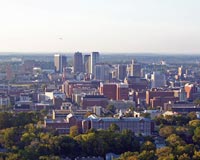 Although Birmingham is the leading light in the West Midlands office market, the M42 Corridor to the south-east of the city, is also shining strongly.
Although Birmingham is the leading light in the West Midlands office market, the M42 Corridor to the south-east of the city, is also shining strongly.
“There are striking similarities between the M42 out-of-town market and the city centre,” says Will Ventham, office agency director at CBRE.
Healthy take-up in the first three quarters of 2014 was broadly the same, when the exceptional letting to HS2 is stripped out: 318,000 sq ft in the M42 corridor, compared with 372,000 sq ft in central Birmingham.
Supply of grade-A space is limited, too. According to GVA, business park availability in the Midlands has dropped below 10%, the lowest of any UK region. As a result, headline rents – like those in Birmingham city centre – have bounced back, although a substantial gap of about £10 remains between the £21 per sq ft asking rents along the M42 and £30-plus per sq ft in central Birmingham.
“There is a synchronicity between the city centre and the M42: when one does well, the other will too,” says Ventham.
So, in theory, the prospect of prelets and speculative development that is already looming large in the city centre should be reflected out of town. The availability of plots at locations such as Birmingham business park and Fore business park, where supply of existing space is extremely low, suggests that a prelet before the end of this year is likely, particularly as agents report a number of significant lease ends or breaks in 2016, when prime rents are expected to have reached at least £24 per sq ft.
Whether that will be high enough to spark speculative development is unclear. Some local property experts rule it out; others, like Ventham, remain open to the possibility. But he cautions: “There isn’t a straightforward answer. Tenants will need to start thinking long-term again, as most landlords will want a minimum 10-year term. And the cost of buildings is going up, so that will have to be reflected in the rents.”
Outside the Birmingham/M42 constellation, there are also signs of development life. At Cannon Kirk’s Friargate scheme in Coventry city centre, work is under way on the first phase of 200,000 sq ft. The council took a 100,000 sq ft prelet to kickstart the £1.5bn project, but apart from the RICS, which signed up to 36,000 sq ft, private sector occupiers are yet to pile in.
Carl Potter, director of national offices at GVA, believes they will come, although they will not necessarily be large, professional firms. “Coventry will concentrate on business services and tech-related jobs,” he says.
Other city centre locations, such as Stoke, are likely to remain reliant on an indigenous tenant base. “The major redevelopment taking place there means local occupiers will benefit from a more established heart,” says David Tonks, senior director at DTZ.
Suggestions that the Wolverhampton, West Bromwich and Walsall triumvirate is more black hole than Black Country for offices are perhaps unfair. Rents have pulled away from the parity with industrial, to which they sank during the recession, and are now hovering at £12 per sq ft.
Tonks also reports a growing trend for manufacturing firms that want to expand into more industrial space at their existing plants moving their administrative functions into town-centre locations. Admittedly, the demand is modest – generally for suites of around 5,000 sq ft – but it is likely to bring new life to office space that has been empty for some time.
As not even the most optimistic agent is forecasting speculative development in the Black Country this cycle, refurbishment would seem the obvious solution. The problem, points out GVA’s Potter, is the age of the existing stock. “You will stand the best chance of refurbishing a building that is no more than 25 years old,” he says. “Most offices in the Black Country are older than that, so opportunities are limited.”
This month, Birmingham council is expected to launch a masterplan for the city centre area around Snow Hill. Next year, the first tranche of up to 1,500 staff will start moving into 100,000 sq ft of offices at M&G’s Two Snowhill, following the leasing deal agreed this summer.
Waheed Nazir, the council’s planning and regeneration director, says the location could become a hotspot for engineering professionals. “We’re working to identify supply-chain firms to form a cluster around Two Snowhill.”
Although Nazir expects potential occupiers to come from a broad background, rail-related firms will be high on the list, after Birmingham clinched (with Doncaster) the proposed HS2 college, due to welcome its first students at nearby Eastside in 2017.
“The college fits with the masterplan and gives it greater credibility,” says Nazir, who confirms that an initial multi-million-pound phase will see public realm improvements outside Snow Hill station. “You can’t talk about Snow Hill without talking about the wider area,” he adds, so the masterplan is expected to cover a swathe of property between Newhall Street to the west and Steelhouse Lane to the east.
Gary Cardin, senior director at CBRE and chair of Colmore BID, says: “It needs to be ambitious to establish a clear framework as to how the city can expand. This will also help to address how historic buildings in the area, some of which are listed, are dealt with.”
Local agents can see the opportunities to pull in new occupiers around Snow Hill – they say the supply chain for HS2-related companies is easily identifiable and that Aston University, which specialises in engineering, is close by. But there are reservations about how quickly the area can expand.
GVA director Carl Potter says: “People talk a lot about clusters as if they happen instantaneously, but my view is that they can take 15-20 years to grow.”
Empty offices attract attention
While much attention in Birmingham’s office market has focused on the dwindling amount of grade-A space, investors have been quietly snaffling empty, or soon-to-be-empty, buildings, with around 900,000 sq ft recently sold or likely to be purchased – Aviva has put its 332,000 sq ft Estate on the market, for example.
“I can’t remember a time when vacant or partially vacant buildings were attracting so much interest,” says David Smeeton, head of Colliers International’s Birmingham office.
One driver appears to be competition for space in London and the South East pushing investors into the regions, with Birmingham a top choice.
Prices range from £75 to £120 per sq ft. The bellwether for future pricing is expected to be Louisa Ryland House, put on the market by Birmingham city council this summer. The first round of bids attracted 18 offers and up to £10m is expected to be paid for the building.











